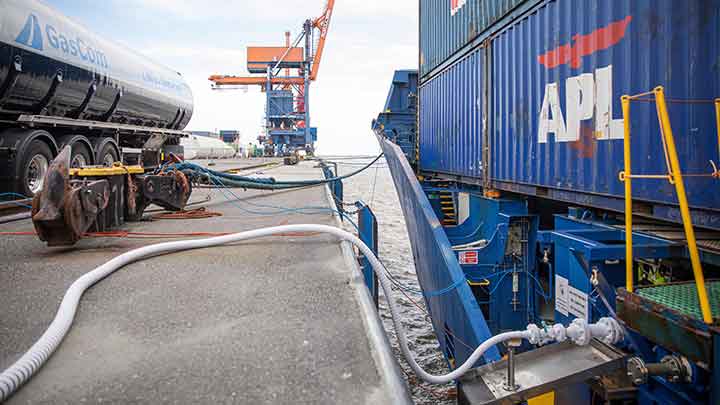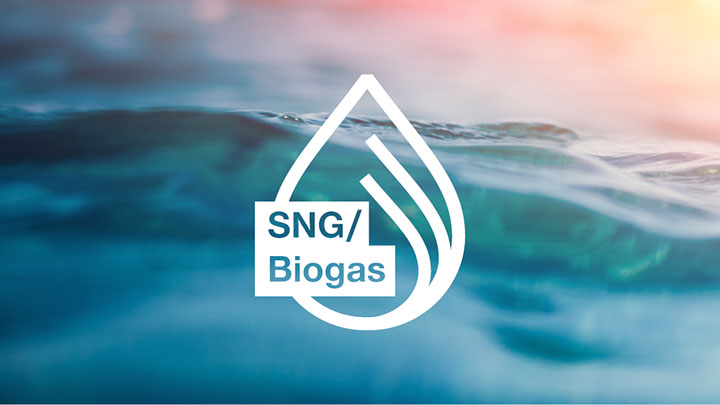SNG: Synthetic gas for the maritime transition

A viable path to decarbonization
MAN Energy Solutions is driving the maritime energy transition with technologies for low-carbon fuels, including green engines and retrofits. Our synthetic natural gas (SNG) solutions offer you a clear path to low-carbon shipping.

From HFO to LNG to SNG
Most of the world's ships run on heavy fuel oil (HFO). The climate crisis has made it essential to find low-carbon alternatives. In recent years, liquefied natural gas (LNG) has become the alternative of choice, but it still a fossil fuel that produces greenhouse gases (GHG). SNG is a new low-carbon alternative. SNG is chemically the same as the main combustible constituent of LNG, so it can used as a direct replacement or blended with LNG, depending on the supply.
SNG as maritime fuel
SNG is optimally suited for the two- and four-stroke dual-fuel engines in MAN’s range and ideal for ships that already run on LNG and aim to save additional emissions. Achieving fuel supply aboard ship is straightforward enough with the right equipment – as with LNG. The new gaseous fuel has to be held at cryogenic temperatures prior to bunkering (-162°C). However, an already established LNG infrastructure can also be used for fueling with SNG.
Reference case: ElbBLUE
World’s first use of SNG in commercial shipping
In September 2021, the 1,036-TEU vessel ElbBLUE, which had been retrofitted with a four-stroke MAN 51/60 dual-fuel engine in 2017, also became the first container ship worldwide to use climate-neutral SNG on a commercial trip. The ship replaced approximately 50% of its bunkered gas fuel with SNG from the Kiwi AG plant in Wertle, Germany. The test proved that any LNG-retrofitted ship can run on carbon-neutral fuels generated by Power-to-X technology.
Read moreManaging Methane Slip
Does the issue of methane slip affect the climate benefits of LNG as an engine fuel for marine applications? Download this paper and find out more about the various countermeasures the company has taken for this purpose.
Synthetic natural gas (SNG) can be derived from fossil fuels and biomass via gasification and methanation processes. SNG can also be produced by, for example, renewable or surplus energy in power-to-gas systems. Biogases are produced from biomass and waste products – and the resulting liquefied fuels can be referred to as BioLNG or LBG (liquefied biogas) and sometimes LBM (liquefied biomethane).
Main advantages:
- SNG and Biogas have the same low NOx, SOx and particulate matter emissions as LNG, but they can be CO2 neutral depending on the feedstock and conversion energy source
- Depending on the source fuel, SNG and Biogas can be a carbon-neutral substitute for fossil fuels
- SNG and Biogas can be blended with LNG to gradually reduce the CO2 footprint
- Considered to be excellent bridging fuels during the ongoing energy transition
Focus areas:
- The availability of SNG and Biogas as bunker fuel
- Increase of production capacities Read more

Solutions / technologies by MAN Energy Solutions:
Two-stroke:
|
|
| Four-stroke: |
|
| Cryogenic equipment |
|
Other future fuels
Related news
Maritime Sector and Green Hydrogen Leaders Agree Ambitious Targets at COP27
At a meeting at the 2022 United Nations Climate Change Conference (COP27) in Sharm El-Sheikh, Egypt, MAN Energy Solutions – along with leading organisations across the shipping value-chain and the largest producers of green hydrogen – signed a ‘Joint Statement on Green Hydrogen and Green Shipping’. The document commits all signatories to the rapid adoption of green hydrogen-based fuels during the current decade in order to achieve the full decarbonisation by 2050 of the shipping sector, one that currently accounts for 3% of global greenhouse gas emissions. It also calls on policymakers to match these ambitious targets.
CEO Uwe Lauber, signed the Joint Statement on behalf of MAN Energy Solutions and said: “Decarbonisation of the marine industry is a mammoth undertaking but, I believe, eminently achievable through cooperation with like-minded industry partners. At MAN Energy Solutions, we believe that hydrogen has a key role to play in getting to net zero and our recent, significant investment in our hydrogen subsidiary, H-TEC SYSTEMS, intends to quickly transform it into a mass-producer of PEM electrolyzers. More than anything, the world needs a massive amount of industrially-scaled, green hydrogen production to build momentum for the broad adoption of hydrogen as a maritime fuel.”
The Joint Statement was facilitated by Climate Change ‘High-Level Champions’ – UN nominees that connect governmental work with the voluntary and collaborative initiatives taken by cities, regions, businesses and investors – and nonprofit energy organisation, RMI. Besides MAN Energy Solutions, it was also signed by – among others – the Aspen Institute, the Global Maritime Forum’s Getting to Zero Coalition, the Green Hydrogen Catapult, InterContinental Energy, and A.P. Moller - Maersk.
Signatories have agreed to pursue cross-sector collaboration to achieve:
- commercially-viable, zero-emission, deep-sea vessels from 2030 with the intention of using exclusively zero-emission-powered ocean-freight services by 2040;
- the scaling-up of green hydrogen production to 5.5 million tons per year by 2030;
- the full decarbonisation of the shipping sector by 2050 at the latest.
They also called upon international authorities and national governments to support private-sector commitments with a correspondingly ambitious policy, and specifically asked the International Maritime Organization and member states to commit to a 100% emissions reduction within the maritime sector by 2050 with robust, interim targets.
Documents
-
PR MES_COP27 Declaration_EN
Contact
Nils Søholt
Trade Press Marine
Group Communications & MarktingMAN Energy SolutionsTeglholmsgade 412450 Copenhagen SVDenmark
nils.soeholt@man-es.com t +45 33 85 26 69